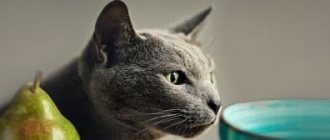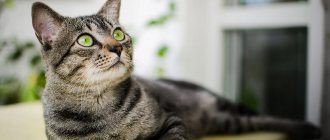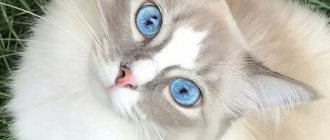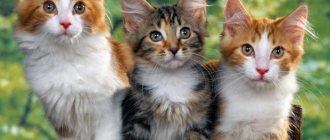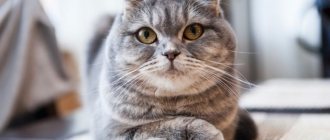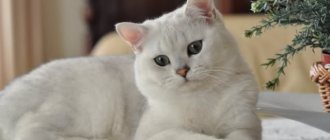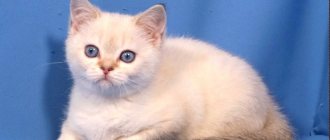The British Chinchilla is undoubtedly a beautiful and rare species of all the colors of British cats, the most difficult to breed, and therefore quite expensive. This color appeared relatively recently and has gained high popularity among British lovers. British chinchilla cats have varying degrees of color depth (see below for types of colors) and come in two base color options: silver and gold. Moreover, both options are interesting in their own way.
At the moment, the color is still being improved and breeders, taking into account all the standards, are working on a good breed type.
Description and features
There are plenty of exquisite cats in the world. And among the most amazing and beautiful breeds of these graceful charmers, one can highlight the silver chinchilla . It should be noted that this name was received by these cats for a very special type of plush coat with an impressive silver color.
This animal’s coat is very reminiscent of the thick fur of the cute rodent chinchilla, which has long been famous for its tenderness and play of light tints. In honor of the mentioned funny animal, this breed received its unique name.
The silver effect in such cats is created due to a light touch of dark on light fur. Visually, this gives the impression of a veil draped over the body of a four-legged creature, which also extends to the animal’s tail and its paws.
The appearance of this wonderful creature is clearly visible in the photo of a silver chinchilla . Her entire being exudes royal dignity, majestic strength and silent calm. These qualities are confirmed not only by appearance, but also by character and behavior.
Silver chinchillas have a calm character
This cat is distinguished by its flexibility, extraordinary insight and intelligence, and intellectual restraint. Such an animal does not show nervousness, does not scratch others over trifles, does not have the habit of damaging the owner’s furniture in comfortable homes, and adapts perfectly to a wide variety of conditions.
The chinchilla considers it beneath his dignity to violently express emotions: satisfaction or irritation. Natural patience gives her the ability to endure long-term loneliness. But if a beloved owner comes home, then this sweet creature will definitely find a way to express her deepest respect, devotion and love towards him.
Restraint and aristocracy are inherent in this breed even in kittens. In the morning, they tactfully wait for their patrons to wake up before rewarding them with their caresses and demanding attention and care from them. This shows the nobility of the breed.
Adult cats are incredibly smart, and even meow with a certain intonation, by which you can easily guess their thoughts, emotions and moods. Moreover, they love to communicate with their owners, which broadens their horizons and shows a desire for active improvement.
But even such domestic creatures show curiosity and activity strictly in moderation. In addition, they cannot tolerate interference from bipeds into their personal space. People can pet them, but they won’t allow themselves to be squeezed. And when they feel the need, they may well show persistent stubbornness if they see that their interests are being violated.
In this case, putting pressure on them and even persuading them is completely useless. They become attached to only one of the two-legged patrons, recognizing him as the true owner, but they love him with all the devotion of a cat’s heart.
Breed standards
The cat of the silver chinchilla breed stands out from the female cat with expressive cheeks, which is very striking. From birth, such creatures are endowed with a muscular large body, as well as a squat body, because such animals, in accordance with their characteristics, have short legs.
Other distinctive features of chinchillas are:
- straight back;
- wide chest;
- small neat ears on a round head;
- the eyes are round, large, bordered with black, green with turquoise or blue, sometimes amber;
- the nose is slightly flattened, wide, short, light brown in color with a border;
- neat, but widened paws;
- a thick short tail (according to standards, it should be half the size of the body);
- there should be hair on the paws between the toes;
- body hair shade is light with darkening,
- the back, as well as the tail and sides, are slightly darker than the main color background;
- the color is varied, it can be classic silver, but it can also be complemented by other impressive, original and rare shades: smoky, tortoiseshell, marble, gold, other colors, as well as their combinations and patterns;
- The length of the coat depends on the subspecies: it can be of medium size, there are short-haired specimens, but at the same time they are fluffier, and there are also long-haired chinchillas.
What are they?
Golden chinchillas come in short-haired and long-haired varieties. If it seems that caring for long hair is more difficult than short hair, then this is, of course, a misconception. Any animal needs care, and seasonal shedding simply cannot be avoided, either by animals with long or short hair. Everyone needs to be brushed constantly.
According to breed standards, golden chinchillas with green eyes are most often found, but options with blue and yellowish eye tints are not excluded. The blue color is mainly found in silver chinchillas.
Golden British chinchillas should not have a pronounced pattern on their coat; as a rule, these are soft and gentle transitions from one shade to another.
Kinds
The ancestor of the breed, an original-colored cat named Shinny, was an inhabitant of Mrs. Hart’s nursery in England at the end of the 19th century. It was there that she was first discovered and noted as the owner of a special color, and then acquired by another breeder named Vallance for further breeding and producing offspring with a valuable trait - silver wool.
Further, one of Shinny's male descendants really became very famous, became the winner of many exhibitions, was awarded prizes and went down in history as the first chinchilla cat. It was for him that an exhibition class of such extraordinary cats was founded in 1894.
The first representatives of the silver chinchilla breed had a pure silver color, marked by an indeterminate tabby pattern, which is now commonly called ghostly or shadow. But they were few in number, and therefore to continue the family it was necessary to cross them with blue, smoky, and silver tabbies of different colors.
This interfered with the conservation of the breed. Therefore, the color of its representatives of those times could not be called established. The cats looked either too dark or unevenly colored. And only with an increase in the number of suitable applicants (around 1930) did the possibility of targeted selection become possible.
Initially, there was only the Persian (as it was later named) long-haired subspecies. According to color, its representatives were divided into “silver shaded” cats, too dark in color, and real chinchillas - lighter, the ends of whose hair were colored only an eighth of the total length.
Silver Chinchilla Persian
New specimens of the so-called ticked chinchillas have also appeared, that is, cats that do not have stripes or spots in their colors, whose hair is colored evenly, but differs in shade in different zones, which gives the effect of a slight shimmer and an impressive play of color.
Ticked chinchilla
The Persian subspecies still exists. Such specimens are distinguished by luxurious arctic fox fur, emerald eye color, a nose resembling a red brick, black paw pads and lips. In those days, this type was crossed with exotic and British cat breeds, which yielded results and the emergence of new subspecies.
The British silver chinchilla cannot boast of long hair, unlike its ancestors. It has a short coat, but its fur is famous for its thickness and fluffiness.
The coloring of such creatures, like other true chinchillas, is white with colored ends of the hair, a peculiar dark coating, the shade of which can be very individual in different individuals.
Green eyes with dark eyeliner stand out against the background of delightful fur, which makes them unusually expressive with such “makeup”.
The Scottish silver chinchilla was also bred from long-haired Persians . Typically, such specimens have medium-length hair, but, in fact, in terms of external characteristics they are not much different from the British, which is not surprising, because these two subspecies are very closely related. When breeding Scots, representatives of the British subspecies were used quite often.
Chinchilla ears can be erect, that is, the most common, and also strike a very original “owl” shape. Instances of the latter have ears tightly pressed to the head, repeating its outline, which are practically invisible.
A cat with a similar trait is usually called a silver fold chinchilla . These are considered especially exotic.
Health
A true Englishman sleeps with the window open in winter, takes walks in rainy weather and hardens himself in the cold. True English cats do not lag behind their fellow countrymen. The British breed is very healthy and is not known to suffer from hereditary diseases, with rare exceptions.
Some diseases, which, however, are characteristic of the entire cat tribe, are often found among them. Firstly, British cats are susceptible to gingivitis. Typically, periodontal disease begins with inflammation of one tooth, which will progress if this inflammation is not addressed. After a while, gingivitis will affect 25% of teeth, at the third stage – 30%. Then advanced periodontitis sets in, the gum tissue recedes and the disease spreads to the roots of the teeth.
The second disease that threatens the British cat is hypertrophic cardiomyopathy, which, unfortunately, cannot be treated. This is a disease of adult animals that is easier to prevent than to treat.
Her symptoms:
- anorexia;
- loss of interest;
- weakened heartbeat;
- difficulty breathing, breathing with sounds;
- sudden paralysis of the hind limbs;
- bluish color of paw pads.
From the first year of a kitten’s life, we recommend having an ultrasound of its heart twice a year. If by the age of 8 the disease is not detected, then you can breathe out and sleep peacefully.
Another scourge of the British is Christmas disease, in other words, hemophilia B. It is characterized by increased bleeding after injuries or surgery.
The list of diseases to which the British breed is susceptible ends with claw fungus. Outwardly, it looks like spots on the nails and their deformation. Periodically and systematically inspect your pet's limbs.
And don't forget about vaccinations! Thanks to vaccinations, you can reduce the risk of contracting panleukopenia, calcivirosis, rhinotracheitis, rabies, and chlamydia.
Traditionally, kittens are vaccinated at 2-3 months or at 8 months, when their teeth change. First, the animal is given an anthelmintic drug. If worms are detected after 10 days, repeated deworming is carried out and after another 10 days they are vaccinated. If worms are not detected in the feces immediately, then after 10 days they are vaccinated as usual. Do not forget to quarantine for about 2 weeks after each vaccination.
The rabies vaccination is done separately immediately after changing teeth and is repeated annually. If all recommendations are followed and with the support of the higher powers of the feline Olympus, the life expectancy of British cats and cats is impressive - up to 15 years. But even a decade and a half is not the limit for the British. It is known that the British ginger cat Poppy was included in the Guinness Book of Records in 2015 as the oldest cat of our time. 24 years is a decent amount of time for an old lady! So, in general, the lifespan of a British subject depends on heredity, conditions, and your care, of course!
Care and maintenance
These creatures, who tend to behave with true royal dignity, in everyday life turn out to be far from being as demanding and picky as it might seem at first.
A big advantage of the breed is that by nature its representatives are endowed with quite good health. However, the care and nutrition regimen should still be followed in order to protect such noble pets from troubles and diseases.
And the first point that should be noted as requiring special attention is the need to monitor the magnificent fur of such pets. Regardless of whether the cat's fur is long or short, it must be combed at least a couple of times every seven days.
The silver chinchilla's coat needs to be brushed once a week.
This procedure is undoubtedly important because excess hair negatively affects the well-being of such high-breed creatures. In addition, it is clear that wool in the house, left in different parts of the home: on furniture in rooms, carpets on the floor and clothes of the owners, does not have a positive effect on the hygiene of the room, and can also cause an allergic reaction.
Another important procedure is monthly bathing. And after this, it is recommended to examine the animal’s eyes, teeth and ears for contamination and the presence of inflammatory foci in them. This is important especially in the summer, because the heat makes it difficult for the cat to breathe and also provokes unwanted discharge in animals. What becomes a consequence of purulent inflammation.
It is better for the owner if he makes it a rule to treat such a sensitive and intelligent pet without irritation, violence, screaming and pressure. Otherwise, the reaction to injustice in a silver chinchilla cat may turn out to be the most unpredictable.
She is independent and loves freedom, and, therefore, she needs personal space - her own camphor and cozy corner for relaxation, which should be equipped with love and taking into account the animal’s personal preferences.
Origin story
The homeland of the chinchilla is considered to be the USA, where in 1880 an ordinary cat with a smoky color gave birth to a kitten with amazing silver fur, playing with tints from light to dark.
Experts were so amazed by this shade of fur that they deliberately began breeding cats with the same color. Today, chinchillas are found in the British and Persian breeds.
Although the formation of this type of cat took place at the end of the 19th century, the standard was approved only in the 80s of the 20th century, almost 100 years later.
As a result of breeding work, cats' eyes acquired a bluish-green and emerald color. The Persian chinchilla was originally bred to have a surprisingly long and smooth coat.
In the late 70s of the last century, this variety began to be added to the British and Burmese breeds.
Nutrition
The menu of such a cat must be varied. But in the diet it is important not to mix homemade food and artificial food, but to immediately choose one of the above. If preference is given to the latter, in this case, when choosing food, it is necessary to take into account the condition of the body, the size and weight of the pet.
Only with this approach will it be possible to select a suitable product in the store. Therefore, for advice on proper nutrition, it would be a good idea to immediately contact a veterinarian who is knowledgeable in these matters.
In general, the body of chinchilla cats is perfectly adapted to digest and accept the meat of rabbit, turkey or chicken. Moreover, such dishes can be served to your pet either boiled or raw, but it is better to cut the meat pieces for lunch into smaller pieces.
You can include fish dishes in the menu, however, not too often, because a couple of times every seven days will be more than enough. You can also give chinchillas low-fat cottage cheese, yoghurts, kefir, but again not in excessive quantities. Vegetables include cabbage and carrots, and the healthiest porridge for a cat may be buckwheat.
As for the diet, the most ideal would be two meals a day (for young cats - three times a day) meals. To ensure that the fur of a magnificent chinchilla is always in the best condition, such creatures need vitamins.
By the way, there are a lot of them in regular artificial food for kittens. However, such diets should again not be abused.
Purchasing a British Golden Chinchilla kitten
Purchasing purebred British chinchilla kittens is not easy. It is better to choose purebred representatives in trusted nurseries or by contacting reliable breeders who breed this particular breed.
Attention! When purchasing an animal on the market or through a private advertisement, there is a high risk of being deceived and becoming the owner of an ordinary kitten with an unusual color.
Criterias of choice
When choosing a British chinchilla kitten, you should consider a number of recommendations:
- Carefully study the breed standard.
- Make a list of breeders and nurseries. Study reviews about them, become familiar with the peculiarities of keeping animals.
- Be sure to look at the kittens' parents, taking into account their compliance with the breed standard. The breeder will certainly provide a pedigree confirming the purebred of the sires up to the 4th generation.
The immediate choice of a kitten should be approached by paying attention to some features:
- Behavior. When a kitten sees a stranger, it should not try to hide in a corner in horror. A healthy baby is cheerful and inquisitive.
- Appearance. The kittens' coat should be shiny, their eyes and ears should be clean, and their nose should be moist.
- Relevant documents: metrics, pedigree, veterinary book, etc.
At what age is it better to adopt a kitten?
Conscientious breeders hand over kittens to new owners no earlier than 3 months .
Babies of this age can already feed themselves and are also trained to use a tray.
Reproduction and lifespan
Selecting a suitable partner for cats of this breed, if you want to get offspring with the required hair quality, is not an easy task and requires a lot of knowledge in the field of animal breeding.
The silver type color is divided into several groups:
- darkened silver (the colored tip of the hair is no more than an eighth of the length);
- ticked (with alternating several light and at least three dark zones on the hair);
- silver shaded (colored at the tip for a third of the length).
Errors in selecting pairs for mating can result in the appearance of silver chinchilla kittens with undesirable hair color. This makes it difficult for the breed to develop. And restoration of the necessary qualities takes two, or even three generations. At the same time, the progressive features of purebred chinchillas may be completely lost.
The problem is also the eye color of these cats. Initially, it was believed that in purebred representatives it must be turquoise (greenish-blue). Later, bright yellow and orange eyes were accepted as acceptable.
But although there are more than enough difficulties, however, thanks to the efforts of breeders and the hard work of breeders, the chinchilla breed is constantly being improved. And even if the kitten does not become a prize-winner at exhibitions, it still pleases its owner.
Such a sublime creature, captivating hearts at first sight, will decorate any home and easily make friends with its inhabitants. The approximate lifespan of such pets, which are naturally in good health, is approximately 15 years.
Breeding
Breeding handsome dogs is quite difficult. Only professionals can achieve the desired color.
Golden kittens can be obtained by the following matings:
- Both parents are golden.
- The parents are silver, but have “golden” genes.
- The male (female) is golden, and the partner is silver, with the golden gene.
If you plan to participate in exhibitions, then both parents must be purebred breeds and colors. There must be no genetic pathologies. Each parent must have all the necessary documents (passport, pedigree and permission for mating) and be vaccinated.
Breeding kittens is a very complex procedure
Cats of this breed mature late. It is best to start mating between the ages of one and a half to two years. The break between matings should be at least 4 months so that the body has time to recover. It’s better to limit yourself to once or twice a year. Pregnancy of cats lasts from 56 to 70 days.
If your pet has given birth to kittens, contact the organization to identify the breed and obtain a passport. This way you can officially sell kittens.
The presence of a pedigree can provide insight into the complete characteristics of the pet. Letters and numbers will show information about the animal.
Breed: BRI - British; PER – Persian; SFL – Scots Fold Shorthair; SFS – long-haired Scots Fold; SCS – Scots with erect ears, shorthair; SCL – long-haired, erect-eared Scotsman.
Color: y – golden; a – blue; b – chocolate; c – lilac; n – black; o – cinnamon; q – faun.
Drawing code: 11 – shaded; 12 – chinchilla; 21 – tabby.
At the end they put numbers indicating eye color: 64 – green; 61 – blue; 62 – yellow.
Price
In Russia, few specialize in this breed. In total, no more than six breeders are engaged in chinchilla cats. Those who have decided to purchase a kitten of such a wonderful breed should know that representatives of its price category occupy the average.
Purebred specimens, which can subsequently be presented at exhibitions and used in breeding, will cost future owners no less than 70 thousand rubles.
There is also a cheaper category of chinchilla kittens, which are estimated at 30 thousand. As a rule, such specimens of the breed, from the point of view of experts, have some kind of flaw, and they are not intended for breeding and showing.
